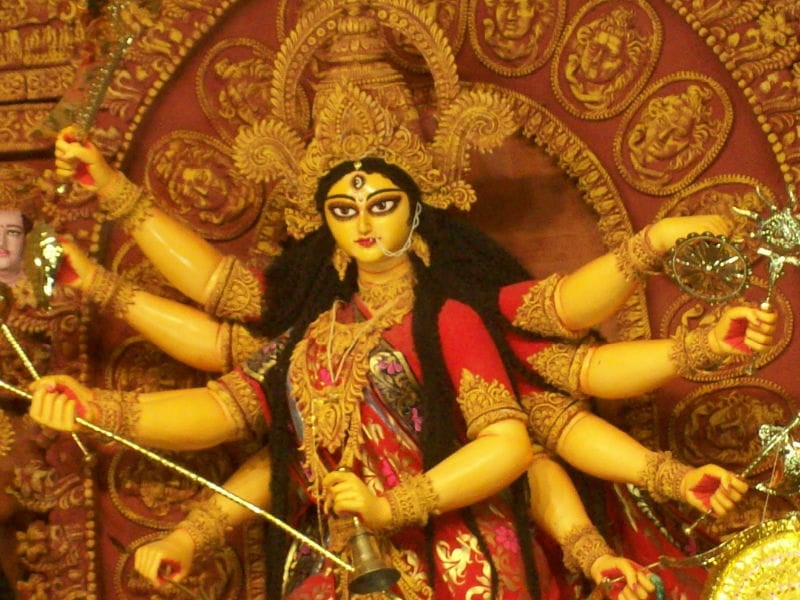For a few hours that morning, all rules of etiquette drilled into us by the Irish nuns at school were cast aside, along with our prim pink-and-white uniforms. We were meant to be drenched with color that day, and our mothers made sure we left home wearing our oldest clothes. The naive victim who pleaded, "Stop, stop, please!" only invited more assaults. At the end of the day, our painted selves were the colorful evidence of the fun we enjoyed playing Holi.
The spring festival Holi comes in March, when daffodils blossom in the northeastern United States and devout Catholics fast during Lent. Halfway around the world in India, Hindus celebrate Holi by squirting colored water or powder on one another, dancing, drinking thandai (sweet milk enriched with dry fruits), and offering special food to the gods. In some parts of India, thandai is laced with a heady dose of bhang, an intoxicating herb that has an effect similar to opium.
For most Hindus living in the U.S., however, Holi is no longer the uninhibited holiday they celebrated back home. For them, the colorful part of the festival survives only in the tiny pots of gulal they pick up from Indian grocery stores to place before the altar at home.
After the puja, or worship, her husband and their 5-year-old daughter and 7-year-old son play Holi by dipping a finger in the gulal and putting a tika, or round dot, on one another's foreheads. "It's not the same as throwing and dodging water balloons like I used to as a child," she admits. "But we later visit with family members to eat an elaborate dinner, so it makes the day special."
Jayashree Modi, a Lawrenceville, N.J., resident, takes her children to attend Holi celebrations at the Swami Narayan temple in Edison, N.J. The temple organizes cultural activities, including dance and drama competitions, and a puja where idols are set on a flower-decked swing. Some 200 people attend every year.
"I've taken my children for Holi celebrations for five years," says Modi. "At least they get familiar with our religion and the meaning of Holi."
In Hindu mythology, Holi celebrates the victory of the god Vishnu over Hiranyakasipu, a demon king. Hiranyakasipu had a boon from the god Brahma that protected him from being killed by a human being, beast, or god. He also could not be killed during the day or night, by hand or by weapon, indoors or outdoors. Thinking himself indestructible, Hiranyakasipu demanded that the world worship him. But his son Prahlada, a Vishnu devotee, refused. A jealous Hiranyakasipu decided to kill him.
First the king got his sister Holika (who gives Holi its name) to sit on a burning pyre with Prahlada on her lap. A boon protected her from being burned. But since Holika misused her special power with the intention of killing Prahlada, she perished.
Exasperated, Hiranyakasipu tried again. One evening, he pointed to a pillar in the doorway of his palace and asked if Vishnu was in that pillar. When Prahlada said yes, Hiranyakasipu had the pillar heated and asked his son to embrace it.
The victory of Prahlada's faith symbolizes Holi. But the reason children love the festival is the license it offers to have a good, messy time. That sense of raucous fun is what many Hindu parents want to pass on to their children.
"When my children were younger, a few Hindu families met in a park on Holi to squirt water bottles," says Manju Thakur, a nursery school administrator in Los Angeles. "After playing Holi, everybody sat down to a picnic lunch. We did it so our children could get a sense of their heritage."
The families gradually stopped coming as their children grew up. "These days, Holi is not a big affair. Some friends may invite us over, but it's like any other party," she says.
Perhaps it is difficult to retain the Holi mood in a culture where, if you tried to run around the streets throwing water balloons at people in America, you could well get arrested for vandalism. Maybe Holi is not Holi unless one is soaked with color. But for many Hindu parents, the real fear is that if they forget to celebrate the day, they are denying their inheritance.
"My children don't play with color and have never thrown water balloons," says Modi. "But Hinduism is their religion, and I take them to the temple for Holi as a way of making them remember that."

